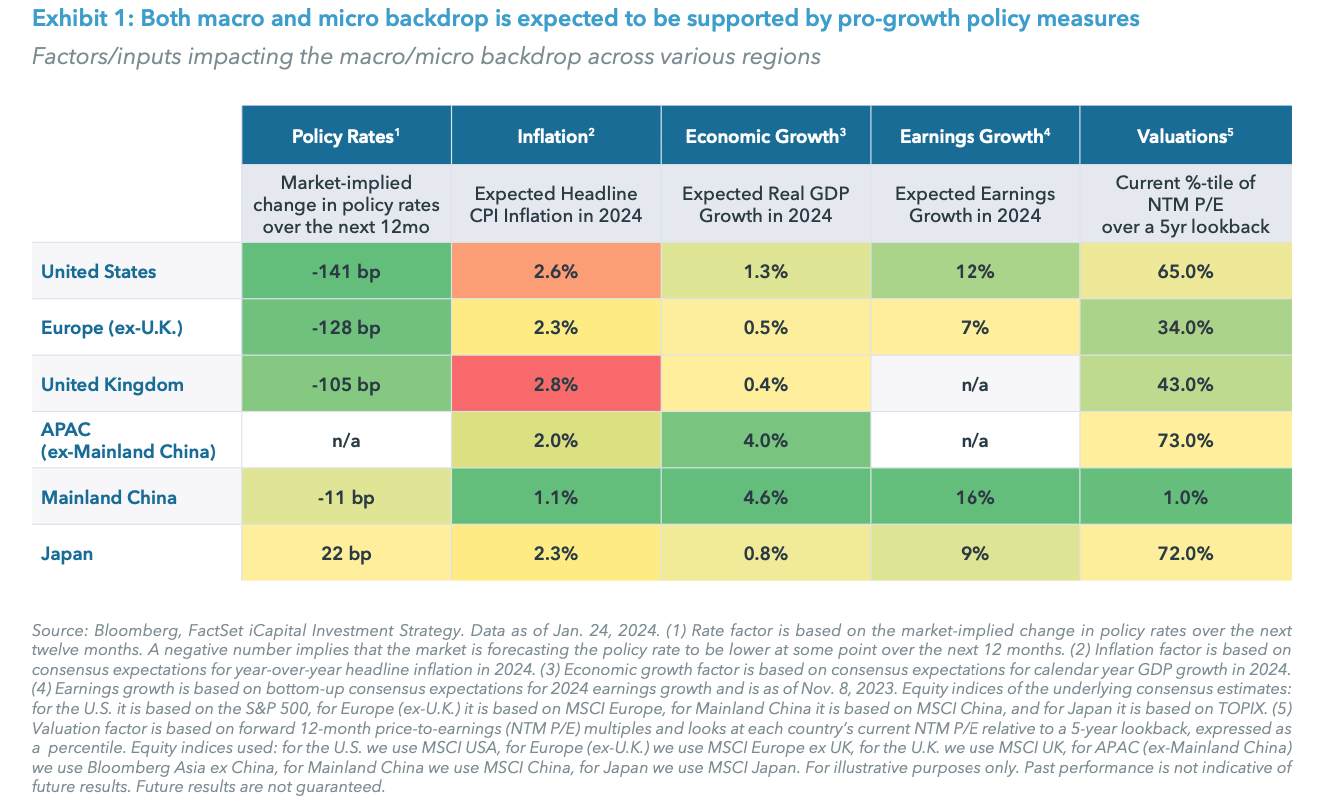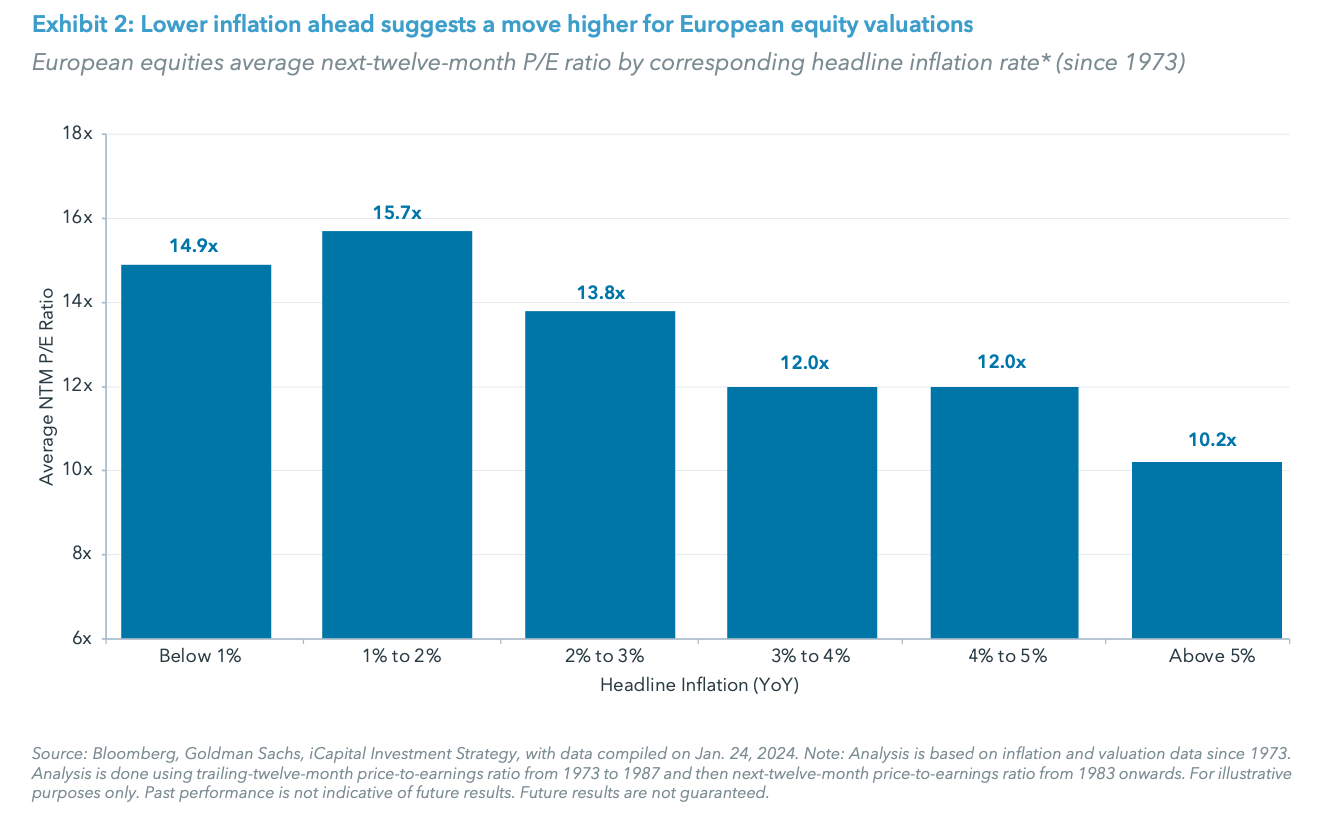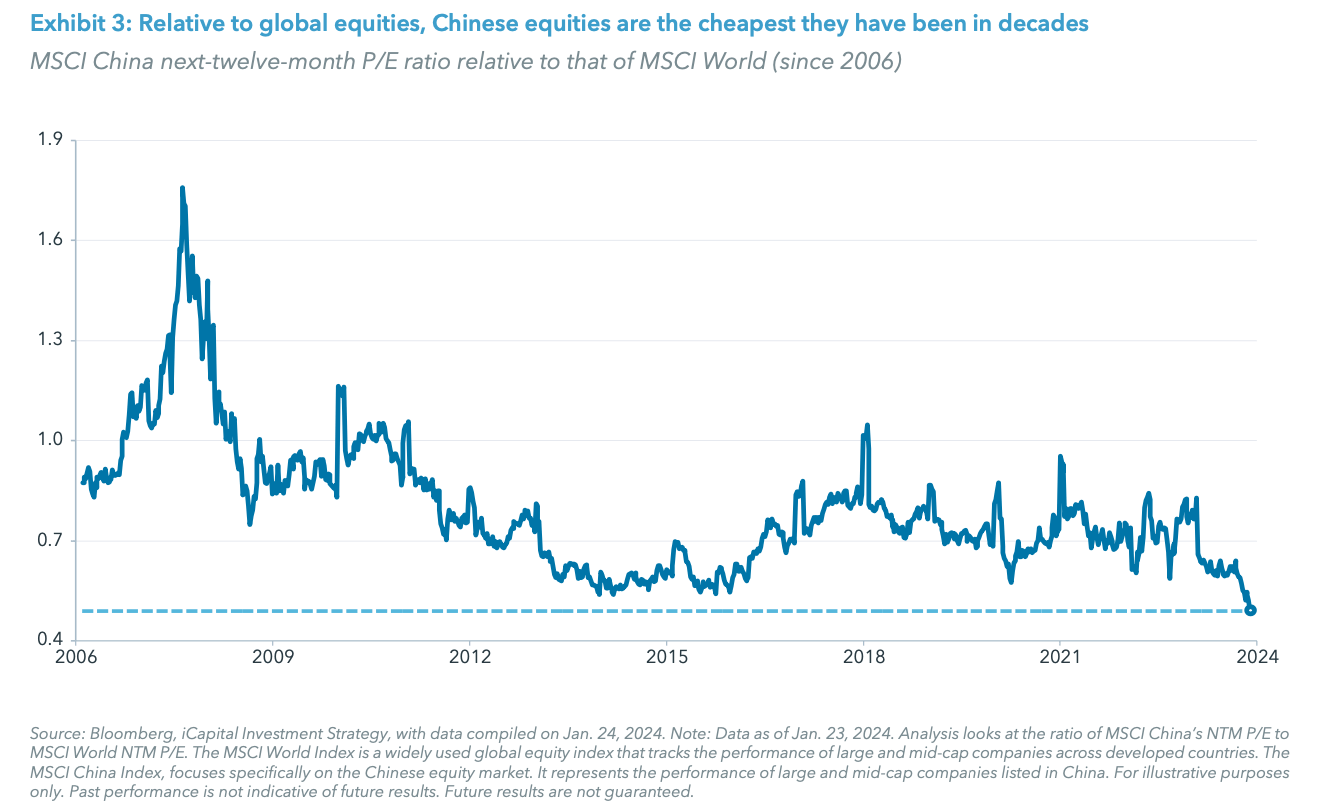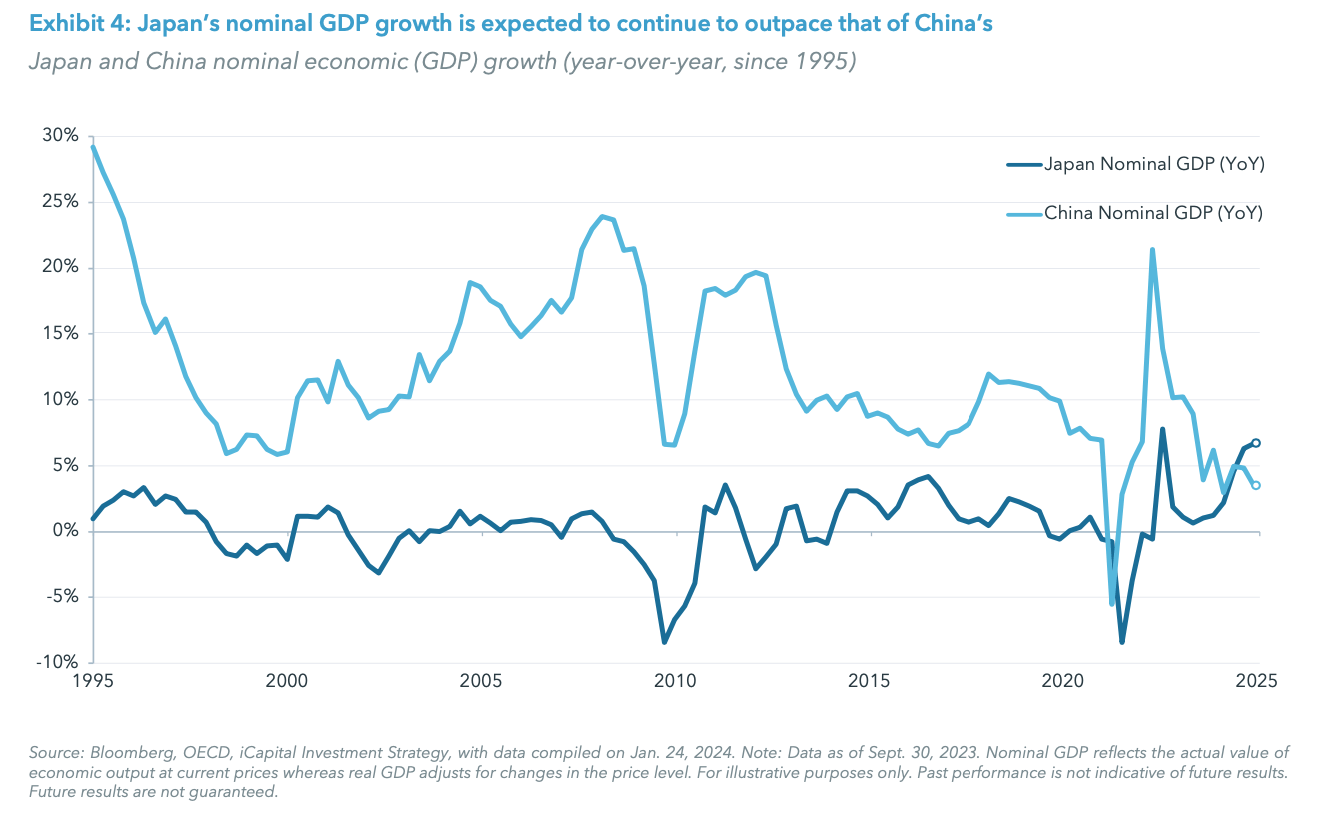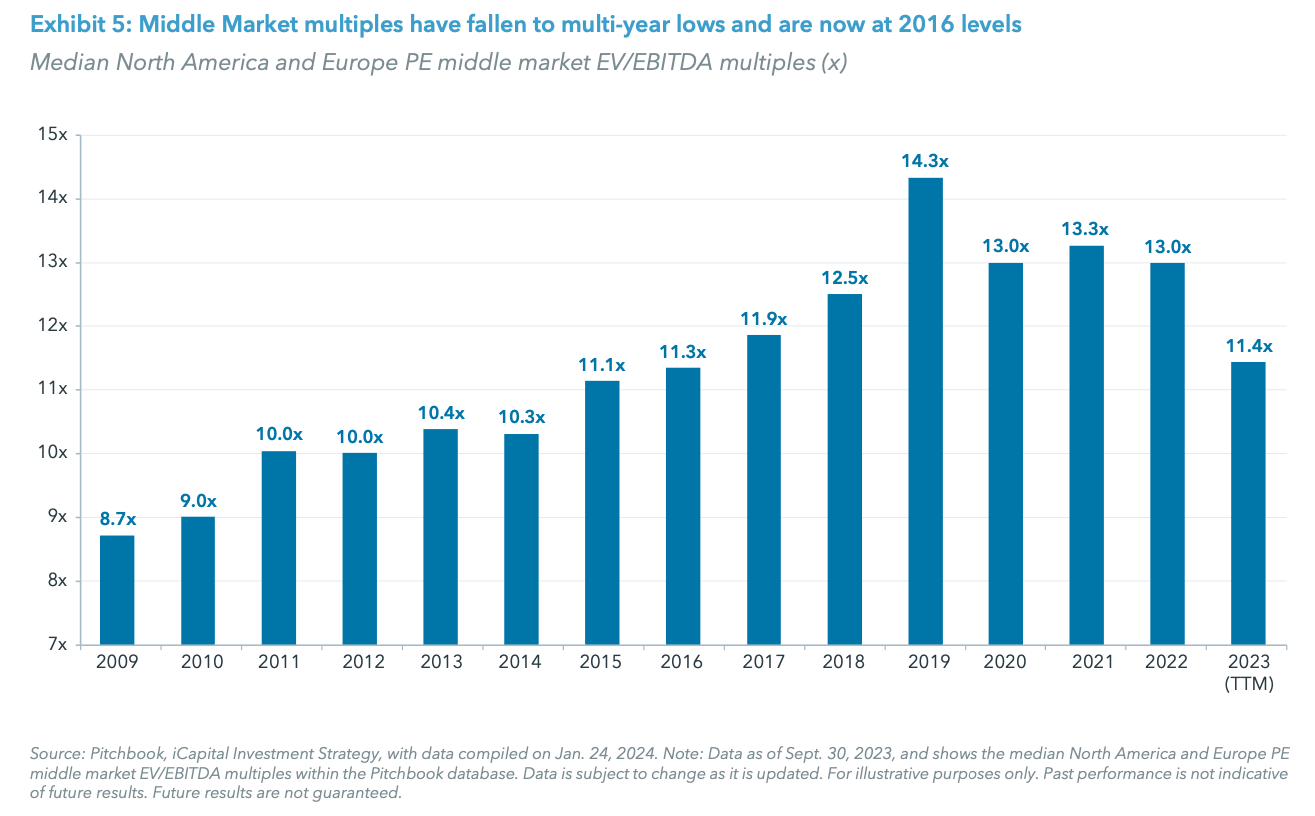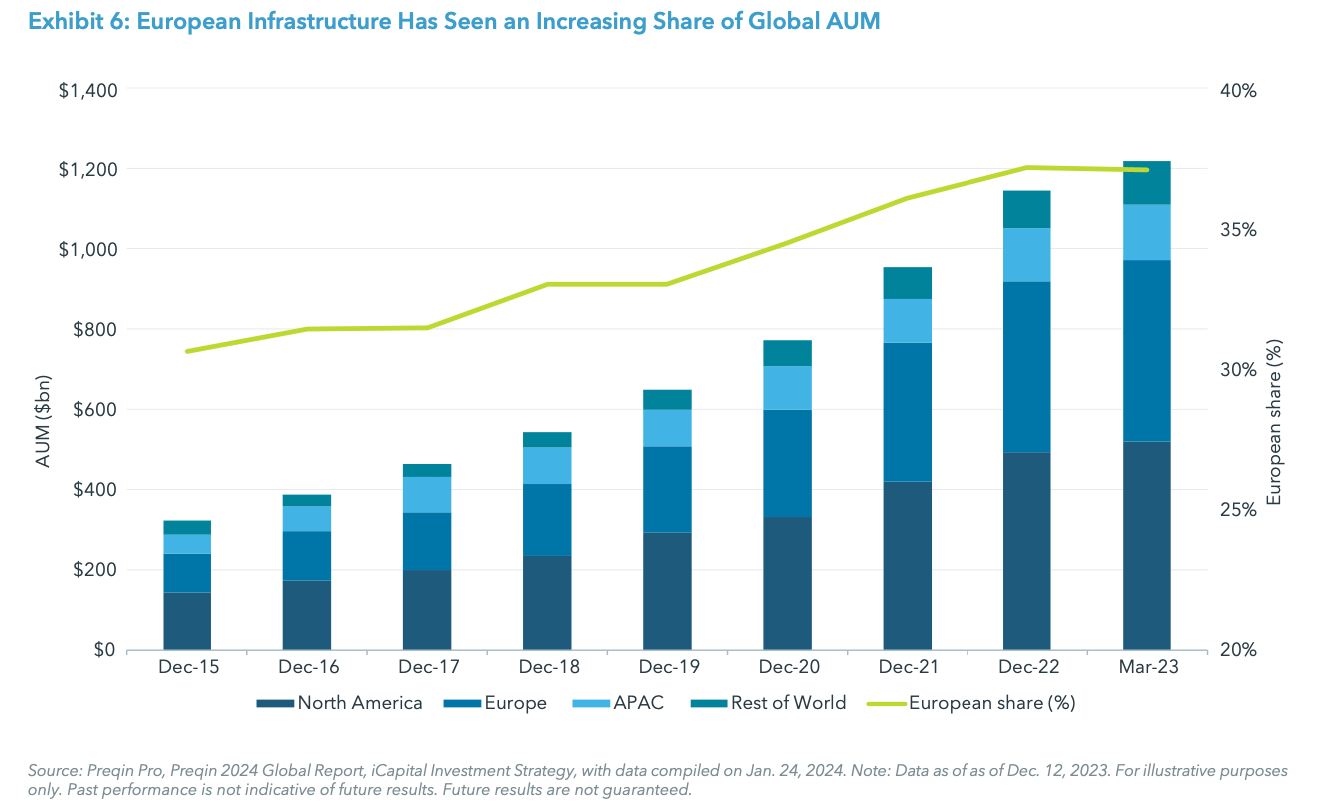Global Landscape
We believe that the trajectory of inflation and central bank policies will be key factors influencing the performance of international markets throughout 2024; these views are similar to those stated in our 2024 U.S. Market Outlook (here). Disinflationary trends across numerous developed market economies should continue with inflation declining further toward a 2% range, albeit at a slower pace. This in turn should prompt central banks to begin their respective rate cutting cycles. Indeed, the European Central Bank (ECB) and Bank of England (BoE) are each expected to join the U.S. Federal Reserve (the “Fed”) in cutting rates with markets currently pricing in roughly five to six 25 basis point (bps) cuts (Exhibit 1).1 Such an environment has the potential to provide further support to many of the global markets. There are, however, some exceptions. Given the different macro backdrop within Japan, the Bank of Japan (BoJ) may adopt a different policy stance relative to its peers, potentially leading to a different rate environment. And in China, further fiscal and monetary policy support will likely be needed to achieve its 5% GDP growth goal.
Europe: Consumer Relief in Sight
European equity markets demonstrated strong performance in 2023, with the MSCI Europe Index posting gains of +16.5% in local currency (EUR) terms and +20.3% in USD terms.2 And while U.S. equities outperformed European equities by nearly 7% (excluding the technology sector), the return profile of European equities became more competitive relative to the U.S.3
In 2024, European markets should continue to benefit from the ongoing disinflationary trend witnessed over the past year and a half. Headline inflation has declined to 2.9% year-over-year (YoY), down significantly from its peak of 10.6% in July 2022, and is projected to fall further to 2.2% by the end of 2024.4 With inflation now nearing the ECB’s 2% target, we suspect the ECB will begin the process of cutting rates, with markets currently pricing in the first cut in the second quarter of 2024.5
The potential for rate cuts is expected to provide support to the European consumer, which faced challenges in 2022, particularly from the sharp increase in energy costs and elevated interest rates.6 Since then, various government initiatives to address the energy situation, coupled with a broader drop in inflation, have led to a pickup in real income growth for the European consumer.7 Current estimates indicate that real incomes are on track to rise by approximately 3% this year.8 At the same time, the European consumer is expected to benefit from a savings rate that is nearly two percentage points higher than it was in 2019.9 This stands in contrast to the U.S. consumer, who has spent down much of the excess savings from the pandemic.10 The anticipation of lower rates should also eventually contribute to lower mortgage expenses for the European consumer, given the primary floating rate nature of their mortgages.11 Together, these developments have the potential to act as a significant positive catalyst and mark the first real consumer spending gains for the European consumer since the fourth quarter of 2019.12
The strength of the consumer may also help European equities sustain their positive momentum from 2023, given consumer-focused sectors account for 21.2% of the region’s equity market. Further, a potential uptick in consumer spending could bolster corporate earnings.13
And as rates move lower and inflation continues to trend downward, valuations should move higher. Indeed, based on history going back to 1973, when headline inflation falls to between the 1-2% range, (which is where consensus sees inflation going), the average forward multiple for European equities averages 15.7x, higher than the current level of 13x (Exhibit 2).14
These factors should also provide support for European middle market private equity, which could benefit from the expected lower cost of financing and higher valuations, as well as the structural advantages of European private vs. public markets. Investors may also want to consider infrastructure, which is not only a defensive asset, but also offers significant thematic optionality on the megatrends of de-carbonization and digitization of the European economy. We detail both ideas in our top investment ideas section below.
China: Growth at a Lower Level
China faced a series of challenges in 2023 as the anticipated post-pandemic reopening failed to materialize. Weak consumer and business sentiment, the overhang from a high debt burden property market, and demographic concerns due to a rapidly growing elderly population (compared to the working-age population) led to concerns about slowing growth momentum and weighed on local markets. To address these challenges, we believe policymakers in China will likely continue easing monetary and fiscal policy measures and stimulate economic growth, which is expected to fall from +5.2% to +4.6% in 2024.15
Over the past three years, there have been several policy measures aimed at stimulating the economy. However, unlike prior easing cycles, these measures seemed to be more targeted, focused on providing support to specific sectors such as property and manufacturing, rather than broad-based stimulus measures seen in 2008 and 2015.16 In 2024, we think policymakers will be more acutely focused on the growth trade-off, as economic growth continues to be one of the key policy priorities. This is different from prior years when the government emphasized structural reforms and increased regulation, referred to as “common prosperity.”
While government officials appear comfortable with a set 5% growth target, should the economic outlook deteriorate further, policymakers are likely to take additional actions. Indeed, if growth in China comes in close to the current 2024 GDP estimates of +4.6%, we believe that would be sufficient weakness to prompt policymakers to enact more stimulus measures over the course of the year.17 In fact, we have just begun to see more supportive policy measures enacted at the start of 2024, including a larger than expected reserve requirement rate (RRR) cut and a stabilization fund to support their domestic equity market.18
On a more positive note, valuations continue to look attractive in China on both an absolute and relative basis. Currently, MSCI China trades at an 8.0x forward P/E multiple, which ranks in the 0.6 percentile over a ten-year lookback.19 On a relative basis, China is trading at its lowest level relative to global equities, proxied by the MSCI World, through at least 2006 (Exhibit 3).20 Important to note, however, despite valuations being cheap across several indicators, lingering regulatory overhang may keep valuations low for an extended period of time, as we saw between 2011 and 2014, or may even put an upward cap on valuations over the near-term.21
The earnings backdrop for China should also be supportive for the outlook for Chinese equites. Currently, earnings are expected to grow by +16% in China in 2024.22 Consensus expectations are elevated as the housing market drags are expected to moderate in 2024. However, China’s earnings are subject to downward revisions throughout the year, as consensus forecasts are usually set high at coming into the new year – similar to what we see in the United States.23
Still, looking at the bigger picture, the Chinese equity market is now comprised of more mature companies with moderate earnings growth expectations.24 For China’s investors, given economic growth is likely to come in at a lower level, it may be prudent for those investors to seek out pockets of higher growth elsewhere. For example, investors may look to China’s private markets, where companies may be growing at a faster pace and where low public equity valuations could be spurring take-private transactions. And globally diversified growth opportunities could make sense given rapid tech adoption and innovation. Finally, as rates settle at a lower level and wealth management products (WMPs) are less abundant, an allocation to private credit could also be considered.
Japan: A Divergent Policy Path
Despite a number of global central banks expected to cut rates in 2024, Japan is expected to undergo a divergent policy path. The BoJ is expected to raise rates by roughly 20 bps, or two rate hikes of 10 bps, which would be the first-rate hike for the BoJ since July 2006. It would also mark an exit from their negative interest rate policy (NIRP), representing a major sea change in policy.25 And even before rate hikes, the BoJ is expected to exit their yield curve control (YCC) in the spring of 2024.26 Ultimately, the forward policy path will likely be largely influenced by the Shunto wage negotiations (also in the spring of 2024) as the BoJ has previously stated its importance in influencing monetary policy.27
Though this regime shift could present a headwind to Japanese equity returns in 2024, favorable factors persist. The government’s continued focus on corporate governance reforms, started last year, is set to continue and potentially intensify in 2024. The Tokyo Stock Exchange (TSE) has implemented various reforms aimed at improving corporate governance, boosting return on equity (ROE), and enhancing capital return. In fact, when TSE first announced these measures, only 20% of companies listed on the TSE had an ROE of 15% or higher, a significantly lower figure than we see in the U.S. and Europe.28
As these targeted reforms continue and the TSE begins publishing a monthly report highlighting companies engaging in these reforms, this could boost the interest of both domestic and foreign investors in entering or adding to Japanese markets. Indeed, we started to see this unfold last year, as a once “unloved” market, finally saw $43.4 billion of foreign inflows in 2023 – the largest yearly inflow since 2014.29
Apart from corporate governance reforms, markets may find additional support in a Japanese economy that stands to benefit from pro-growth fiscal policies announced by the Kishida government for 2024. These measures include tax cuts, cash handouts to low-income households, and subsidies for gasoline and utility bills, with the aim of stimulating economic growth and alleviating cost pressures for consumers.30 It is expected that these policies could boost GDP growth by an additional 0.3 percentage points, though likely serving as a temporary stimulus to growth.31
Japanese equities could also benefit from relative outperformance in both earnings and growth. In terms of earnings, Japan has shown relative earnings outperformance compared to other developed economies, and in fact is the only developed market with a positive earnings revision ratio entering 2024.32 And for growth, despite weaker data at the end of 2023, Japan’s economy has shown resilience, and it is projected that nominal GDP growth will continue to surpass that of China, which it first did in the second quarter of 2023, and that was the first time in three decades (Exhibit 4).33 This faster nominal growth environment should not only support its continued relative economic outperformance, but also feed into its earnings outlook as well. However, the risk to this environment would be a stronger Japanese yen (JPY), which could start to weigh on the earnings outlook for this year. This is especially true for the TOPIX index, which is more geared toward large exporters and industrial companies.34
Given an anticipated return to 2% inflation alongside faster growth within Japan in 2024, Japanese investors may need to reconsider their portfolio allocations, pivoting away from fixed coupon, long duration Japanese government bonds (JGBs) that did well during the YCC and NIRP environment, and instead look to assets that may offer protection against inflation such as real estate, infrastructure, and floating rate denominated fixed income, like private credit.35
Select Investment Ideas for 2024
The theme of our 2024 Market Outlook is a year of greater investor optionality and a much broader opportunity set. Within this context, our top investment ideas are globally applicable, spanning both the public and private markets. For European-specific investment ideas, we favor middle market private equity, where we believe the asset class has structural advantages; and infrastructure with several mega thematic tailwinds.
European Middle Market Private Equity
With the potential for a modest uptick in deal activity and liquidity, middle market private equity is poised to showcase its “structural advantages.” For starters, private equity benefits from a larger number of deal opportunities: in Europe there are 54 private companies for every one public company.36 The asset class also enjoys discount entry buyout valuations on both a relative and absolute basis. Over the last five years, the valuation discount for small and mid-size deals (“middle market”) has widened relative to large buyout deals, and is currently at multi- year lows.37 On an absolute basis, the median PE middle market EV/EBITDA multiple has fallen over the past year to 11.4x, and is now back to 2016 levels (Exhibit 5).38
The other factor to keep in mind is the ability for private equity managers to influence the strategic direction of the underlying businesses. As private equity investors become more involved and help improve company strategy and operations, valuations are likely to expand often at a premium to large cap multiples as public market investors and strategics pay a premium for the enhanced growth attributes of the business. This opportunity – discount entry valuations, premium exit valuations – could be attractive as overall deal activity and exits improve.
Infrastructure
Even if inflation moves closer to the ECB’s 2% target through 2024, investors may still want to look at the infrastructure segment to add protection while gaining exposure to big ticket, thematic upside. As we navigated through the recent rate tightening inflationary cycle, the infrastructure asset class has proven its purpose – providing predictable, and often inflation-linked cash flow.39 Yet as we turn the corner into what could be a more growth-oriented environment, there are big secular themes starting with energy transition and technology that should not only protect asset values but could help managers generate higher revenues and cash flow.
Specifically, the REPowerEU Plan includes policy support and is expected to see investment of over €200 billion by 2027, while the Green Deal Industrial Plan aims to ease the regulatory burden and create a favorable financial environment to accelerate climate transition.40 On the technology side, broad physical investments to expand 5G usage, build towers, data centers and fiber connectivity remain at the forefront for competitive advantage. Each of these initiatives require massive investment, long-term horizons and are well suited for private investment where the ability to enhance operational improvement is vital for investment performance.
This is perhaps one of the reasons why Europe is seeing a larger share of global infrastructure AUM. Since 2015, unlisted infrastructure assets raised by European-focused funds has increased from 31% to 37% as of March 2023 (Exhibit 6).41 As mentioned, the energy sector is a big theme for the infrastructure asset class, and Europe is arguably ahead of other global regions with initiatives for this transition.
For additional top investment ideas beyond middle market private equity and infrastructure, please refer to our 2024 Outlook, available here, which covers a range of globally applicable strategies, including private credit, venture capital, real estate, and more.
ENDNOTES
1. Bloomberg, iCapital Investment Strategy, as of Jan. 23, 2024.
2. Bloomberg, iCapital Investment Strategy, as of Jan. 23, 2024.
3. Goldman Sachs, iCapital Investment Strategy, as of Jan. 17, 2024.
4. Bloomberg, iCapital Investment Strategy, as of Jan. 23, 2024.
5. Bloomberg, iCapital Investment Strategy, as of Jan. 23, 2024.
6. Bloomberg, iCapital Investment Strategy, as of Jan. 23, 2024.
7. Goldman Sachs, iCapital Investment Strategy, as of Nov. 9, 2023.
8. Goldman Sachs, iCapital Investment Strategy, as of Nov. 9, 2023.
9. EuroStat, iCapital Investment Strategy, as of Sept. 30, 2023.
10. Bloomberg, Bureau of Economic Analysis, iCapital Investment Strategy, as of Jan. 24, 2024.
11. European Central Bank Working Paper, iCapital Investment Strategy, as of Oct. 2019.
12. JPMorgan, iCapital Investment Strategy, as of Nov. 21, 2023.
13. Bloomberg, iCapital Investment Strategy, as of Jan. 23, 2024.
14. Goldman Sachs, iCapital Investment Strategy, as of Nov. 14, 2023.
15. Bloomberg, iCapital Investment Strategy, as of Jan. 24, 2024.
16. Bloomberg, iCapital Investment Strategy, as of Jan. 24, 2024.
17. Bloomberg, iCapital Investment Strategy, as of Jan. 24, 2024.
18. Bloomberg, iCapital Investment Strategy, as of Jan. 24, 2024.
19. Bloomberg, iCapital Investment Strategy, as of Jan. 24, 2024.
20. Bloomberg, iCapital Investment Strategy, as of Jan. 24, 2024.
21. Bloomberg, iCapital Investment Strategy, as of Jan. 24, 2024.
22. FactSet, Morgan Stanley, as of Nov. 8, 2024.
23. FactSet, Morgan Stanley, as of Nov. 8, 2024.
24. Allianz Global Investors, iCapital Investment Strategy, as of Jan. 8, 2024. 25. Bloomberg, iCapital Investment Strategy, as of Jan. 24, 2024.
26. Bloomberg, Goldman Sachs, JPMorgan, iCapital Investment Strategy, as of Jan. 24, 2024.
27. BNP Paribas, iCapital Investment Strategy, as of Nov. 6, 2023.
28. JPMorgan, iCapital Investment Strategy, as of Jan. 16, 2024.
29. Reuters, Japan Exchange Group, iCapital Investment Strategy, as of Jan. 12, 2024.
30. Bloomberg, iCapital Investment Strategy, as of Jan. 24, 2024.
31. Goldman Sachs, iCapital Investment Strategy, as of Nov. 4, 2023.
32. JPMorgan, iCapital Investment Strategy, as of Jan. 12, 2024.
33. Bloomberg, iCapital Investment Strategy, as of Jan. 24, 2024.
34. Bloomberg, iCapital Investment Strategy, as of Jan. 24, 2024.
35. Bloomberg, iCapital Investment Strategy, as of Jan. 24, 2024.
36. Pitchbook, iCapital Investment Strategy, as of Jan. 24, 2024.
37. Schroders Capital, Capital IQ, iCapital Investment Strategy, as of Nov. 8, 2023.
38. Pitchbook, iCapital Investment Strategy, as of Sept. 30, 2023.
39. Pitchbook, Preqin, iCapital Investment Strategy, as of Jan. 24, 2024.
40. Bloomberg, European Commission, iCapital Investment Strategy, as of Jan. 24, 2024.
41. Preqin Pro, Preqin 2024 Global Report, iCapital Investment Strategy, as of Dec. 12, 2023.
IMPORTANT INFORMATION
The material herein has been provided to you for informational purposes only by Institutional Capital Network, Inc. (“iCapital Network”) or one of its affiliates (iCapital Network together with its affiliates, “iCapital”). This material is the property of iCapital and may not be shared without the written permission of iCapital. No part of this material may be reproduced in any form, or referred to in any other publication, without express written permission of iCapital.
This material is provided for informational purposes only and is not intended as, and may not be relied on in any manner as, legal, tax or investment advice, a recommendation, or as an offer or solicitation to buy or sell any security, financial product or instrument, or otherwise to participate in any particular trading strategy. This material does not intend to address the financial objectives, situation, or specific needs of any individual investor. You should consult your personal accounting, tax and legal advisors to understand the implications of any investment specific to your personal financial situation.
iCapital Markets LLC operates a platform that makes available financial products to financial professionals. In operating this platform, iCapital Markets LLC generally earns revenue based on the volume of transactions that take place in these products and would benefit by an increase in sales for these products.
The information contained herein is an opinion only, as of the date indicated, and should not be relied upon as the only important information available. Any prediction, projection or forecast on the economy, stock market, bond market or the economic trends of the markets is not necessarily indicative of the future or likely performance. The information contained herein is subject to change, incomplete, and may include information and/or data obtained from third party sources that iCapital believes, but does not guarantee, to be accurate. iCapital considers this third-party data reliable, but does not represent that it is accurate, complete and/or up to date, and it should not be relied on as such. iCapital makes no representation as to the accuracy or completeness of this material and accepts no liability for losses arising from the use of the material presented. No representation or warranty is made by iCapital as to the reasonableness or completeness of such forward-looking statements or to any other financial information contained herein.
Securities products and services are offered by iCapital Markets, an SEC-registered broker-dealer, member FINRA and SIPC, and an affiliate of iCapital, Inc. and Institutional Capital Network, Inc. These registrations and memberships in no way imply that the SEC, FINRA, or SIPC have endorsed any of the entities, products, or services discussed herein. Annuities and insurance services are provided by iCapital Annuities and Insurance Services LLC, an affiliate of iCapital, Inc. “iCapital” and “iCapital Network” are registered trademarks of Institutional Capital Network, Inc. Additional information is available upon request.
© 2024 Institutional Capital Network, Inc. All Rights Reserved.



